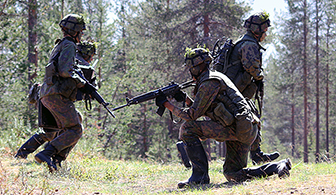Seamless cooperating and all-encompassing effectiveness

This coming August, the cadets studying on the infantry programme of the Infantry School at the Army Academy will be graduating with a Bachelor in Military Sciences and promoted to the rank of Lieutenant. Preceding this, the finishing touches of their training will include, among others, partaking in the Pohjoinen 18 exercise organised in Rovajärvi from late May to early June.
Within the exercise framework, the cadets functioned along firing exercise personnel and conducted anti-tank weapon firing. It is anti-tank missiles, in particular, that seemed to provide inspiration.
- The high point was when I got to conduct firing with antitank missile 2000M covering a range exceeding 2 kilometres, Cadet Warrant Officer Waltteri Mattila tells.
- The missiles remain effective, Cadet Corporal Aleksi Ahde comments.
This cadet training event also involved another anti-tank missile, 83M, which was used for conducting firing that covered a range reaching up to 1,600 metres. The live firing exercise entailed firing with a grenade machine gun as well that targeted a decommissioned main battle tank that became subject to a commendable number of hits.
As part of the live firing, the cadets undertook varying tasks that involved, for instance, serving as the gunner, or as the firing supervisor of the given weapon. The training objective in the beginning phase of the firing was to develop firmness in correct handling of given weapons and ammunition as well as functioning in supervisor capacity. The Officer in Charge of firing and the firing supervisor of the given weapon remain responsible for ensuring the correctness and safety of the personnel operating a given weapon. Becoming fully versed in the versatile tasks part of conducting firing requires a high number of repetitions while training. Developing routines and achieving advanced level competence presuppose sustaining several-year-long training.
- A special feature of the infantry is that we serve as general leaders, which in turn means that we must be competent in everything and comprehend the opportunities of other service branches in supporting the infantry units’ combat. The infantry plans its own operating, and the other service branches support the infantry, Major Mika Metsi explains as the Officer in Charge of firing anti-tank missiles in the Pohjoinen 18 exercise.
Hardly ever does the infantry train and engage in non-supported combat. Therefore the infantry leaders must combine the joint functions of service branches to form an optimally operating effective entity.
Thus sustaining seamless cooperating and trust between service branches becomes topical and remains so at all combat operating levels.
- Take, for instance, the cooperating between a platoon leader and forward observer which must become seamless and build on mutual confidence in each other’s competence to avoid, for example, unnecessary long waiting times. If this objective is achieved, we generate trust in our training having succeeded, Battalion Officer Vesa Piiroinen points out as infantry firing exercise commander in the Pohjoinen 18 exercise.
Apart from sustained seamless cooperating, infantry soldiers and the cooperating units need to remain physically fit.
Infantry combatants must be capable of sustaining dismounted advancement in terrain also long distance and continue to do so while hauling along their own and their units’ essential equipment and weaponry that may easily weigh from 15 to 20 kilos. On top of this, the carrying load may also include section- or platoon-specific equipment, such as radios, anti-tank weapons, or mines.
As for the cadets, following the graduation this autumn, each cadet awaits a versatile career of a commissioned officer to be initiated by serving in instructor duties in given Finnish Defence Forces’ brigade-level units.



